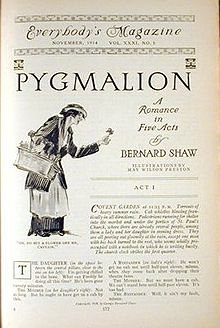I was the guest host last night for Project Shaw‘s concert-style reading of Pygmalion at the Players Club. Since critics are officially “not present” at Project Shaw productions, I speak purely as a civilian when I say that it was one of the most enjoyable presentations of a play by George Bernard Shaw that I’ve ever seen. David Staller’s bone-simple staging was deft and quick, and the actors played their parts with tremendous gusto. I regret to confess that this is my first evening with Project Shaw, but it definitely won’t be my last.
Next up: Saint Joan, on December 17. Don’t miss it.
If you’re curious, here’s what I had to say. Regular readers of this blog may notice that I lifted part of my introductory remarks from a recent Wall Street Journal “Sightings” column. Nobody noticed, so don’t tell!
* * *
It’s a pleasure to be here, and to talk about Shaw, an artist whom I admire greatly in spite of the fact that we have, so far as I know, only one thing in common. Like him, I’m now a critic and a playwright. Now that I’ve worked both sides of the proscenium, I know better than ever before that there are many things about the theater that can’t be learned from an aisle seat! I think I’m a better critic for having written a play and two opera libretti, and I dare say that Shaw might well have become a better playwright for having spent time as a working critic. At any rate, he certainly knew how seriously to take his reviews!
 But enough about me–a sentence that Shaw, so far as I know, never spoke in his life. Let’s talk about Pygmalion for a moment. Nowadays most theatergoers know Eliza Doolittle and Henry Higgins from My Fair Lady, in which Lerner and Loewe sprinkled sugar all over Shaw’s greatest comedy. The real Pygmalion, by contrast, is a double-edged satire of the British class system that takes no less cutting a view of the progressive reformers who, like Shaw himself, sought and seek to flatten it out. He shows us that Professor Higgins, like so many of his well-meaning kind, prefers people in the mass to individual human beings. He treats Eliza like a lab rat, not a creature of flesh and blood, and her scornful dismissal of his high-minded heartlessness rings as true today as it did in 1913.
But enough about me–a sentence that Shaw, so far as I know, never spoke in his life. Let’s talk about Pygmalion for a moment. Nowadays most theatergoers know Eliza Doolittle and Henry Higgins from My Fair Lady, in which Lerner and Loewe sprinkled sugar all over Shaw’s greatest comedy. The real Pygmalion, by contrast, is a double-edged satire of the British class system that takes no less cutting a view of the progressive reformers who, like Shaw himself, sought and seek to flatten it out. He shows us that Professor Higgins, like so many of his well-meaning kind, prefers people in the mass to individual human beings. He treats Eliza like a lab rat, not a creature of flesh and blood, and her scornful dismissal of his high-minded heartlessness rings as true today as it did in 1913.
I think that much of Shaw’s effectiveness as a dramatist of ideas inhered in his absolute willingness to give the devil his due, and I think that Pygmalion might just be the best example of that willingness. But Shaw was no less alive to the contradictions in his own nature than to those in his characters, most of whom are mirrors in which bits and pieces of their creator are vividly reflected. Instead of making love, they talk rings around it–even the ones who long most for intimacy. They believe in rationality, but embrace the apocalypse of total war with a pathetic blend of ecstasy and relief, just like Shaw, who opposed British involvement in World War I but was himself a power-worshipper with a totalitarian itch who believed passionately in human perfectibility. And though they joke and joke and joke, they’re always kidding on the square, telling their brutal truths with such impish charm that you scarcely feel the knife slipping in until the blood starts to flow.
That is Shaw in a nutshell. He is a serious comedian, an artist who knows that in most human lives, absurdity and sorrow are woven together too tightly to be teased apart–and that it is comedy, not tragedy, which illustrates that fact most fully. Life is too complex to be painted solely in shades of black. Even as Shakespeare made room in Lear for the Fool, so does Shaw make room in his theatrical sermons for the pungent humor that, as Henry James so truly said, is the saving salt. So tonight, let us laugh with him…and at ourselves.
* * *
George Bernard Shaw on capital punishment:
Terry Teachout on the arts in New York City
An ArtsJournal Blog
